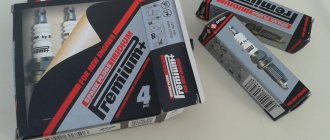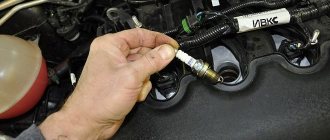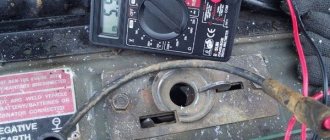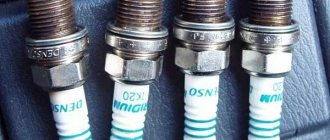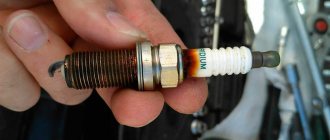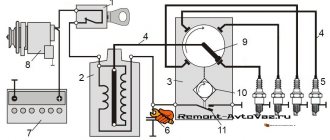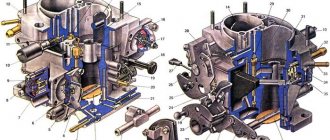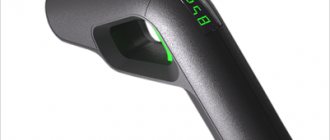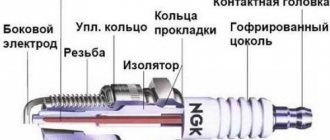Selection options
To select good SZ, you must be guided by the following criteria:
- The first parameter to consider when purchasing is the heat rating. It should be noted that this parameter is conditional and not universal, so it must be selected in accordance with the model of a particular motor. This number shows the pressure level in the internal combustion engine cylinder at which glow ignition occurs. The use of SZ with a higher heat number is allowed, but is not prohibited if it is lower.
- Another parameter is the possibility of self-cleaning. Unfortunately, this parameter can only be accurately verified in practice, since all SZ manufacturers promise consumers a high level of self-cleaning. If this indicator is really high, then carbon deposits will not form on the SZ, which is especially important for their optimal operation.
- When buying spark plugs from a VAZ, you also need to take into account their gap. Each manufacturer sets the appropriate gap for individual product lines. If we are talking about domestically produced cars, then in this case this gap on the VAZ spark plugs should be 0.5-0.7 mm.
- Traditional SZ are equipped with two electrodes - one central and one side, but not so long ago global manufacturers began producing devices with 3 and 4 electrodes. These electrodes cannot produce multiple sparks - their purpose is to provide more consistent sparking. Accordingly, the use of such SZ contributes to more stable operation of the power unit due to improved ignition procedures.
- Before purchasing SZ, carefully inspect them for mechanical damage. If you see that there are cracks on the device’s body, then it is better to refuse to purchase such SZ. Also, before installation, check that the gap is the correct size.
- To diagnose purchased SZ, you can install them in a pressure chamber, of course, if you have such an opportunity, then adjust the pressure in it to about 10 kg/cm2, and the current should be connected with a value of 22 kV. As a result, a spark should begin to form. If the spark appears intermittently, this indicates that the SZ is not working, but if the sparking is continuous, then the devices can be purchased (the author of the video is Nail Poroshin).
TOP best manufacturers of spark plugs for VAZ
So which SZ for VAZ is better to choose?
Below is a list of the most popular device manufacturers:
- ZAZS. VAZ vehicles are equipped with such SZ during production. The manufacturer recommends using ZAZS, citing the fact that these spark plugs are most optimal for domestic engines. However, many car enthusiasts do not trust this manufacturer and install SZ from other brands on their cars.
- Beru. In particular, we are talking about the 14FR-7DU model. The main feature of such SZ is the use of a copper central electrode in the design, which has a nickel shell. Thanks to this, the SZ of this model is more resistant to corrosion and wear. The skirt is made in a conical shape, thanks to which the device quickly switches to self-cleaning mode. In addition, the spark power in these fire protection systems is quite high; accordingly, the combustible mixture will burn most efficiently.
- Champion, namely the RC9YC model. If you believe the manufacturer, then such SZ have lower performance in terms of gasoline consumption. In addition, they are more stable, and their power when operating at higher engine speeds is higher.
- NGK is one of the brands that supplies the highest quality products to the domestic market. The nickel model BCPR6ES-11 is currently considered one of the most affordable options. A power unit with such devices will operate more steadily. And when the driver presses the gas pedal, the engine can operate 4% more powerful than with traditional SZ. Separately, we should highlight the iridium spark plugs on the VAZ. If you decide to purchase iridium spark plugs at VAZ, you will be faced with a large assortment of models. They differ from each other both in cost and in characteristics. It should be noted that iridium spark plugs on VAZ have a longer service life. Depending on the model, iridium spark plugs on a VAZ can last up to 100 thousand kilometers or even more. Of course, such advantages also affect the cost of SZ as a whole. Iridium spark plugs on VAZ have an iridium electrode, which makes the spark even more powerful.
- Denso Q20TT. Such devices have a thinner electrode, for the manufacture of which precious metals are not used. Accordingly, this has a positive effect on the price of SZ. As practice shows, when using such devices, the engine power will be higher, its dynamics will increase, and fuel consumption can be reduced. Of course, we are talking about a normally running engine.
- Czech-made devices Brisk DR15YC are equipped with a copper core, as well as a longer electrode insulator, thanks to which the SZ can more quickly switch to self-cleaning mode. Accordingly, the use of these models is more relevant for vehicles that are used in urban environments. As for the replacement interval, in this case it largely depends on the quality of the fuel.
- Bosch FR7DCU. Such SZ are equipped with a copper core mounted to a chromium-nickel shell. Accordingly, this enables the electrode to be more resistant to erosion or corrosion. Thanks to the use of nickel plating, the likelihood of thread sticking is minimized.
- Finwhale F516. The body of this model is characterized by galvanic coating and is made of ductile steel. In addition, this model has good electrical insulation, as a result of which heat conductivity will be higher, which is ensured by the high content of aluminum oxide on the insulator.
Product added to bookmarks!
APPLICABILITY: VAZ 2104, 2105, 2106, 2107, VAZ 2108, 2109, 21099, VAZ 2110, 2111, 2112, VAZ 2113, 2114, 2115, VAZ 1117, 1118, 1119 (LADA-Kal ina), VAZ 2170, 2171, 2172 (LADA-Priora), VAZ 2190, 2191 (LADA-Granta), VAZ 2192, 2194 (LADA-Kalina 2), VAZ 21214, 21313 (Niva), VAZ 2123 (Niva-Chevrolet, Chevrolet NIVA) with 8V injection engine
The V-Line spark plugs have advantages that apply to the entire program.
From a technological point of view, this principle is brilliantly simple - but very effective:
A V-shaped notch is made in the central electrode of the V-line spark plugs. As a result, the ignition spark jumps to the outer edge of the central electrode. There is more fuel in this place than between the electrodes. And one more thing: the required ignition voltage is reduced. This way, the reliability of ignition increases! Especially in modern engines, which use a very lean fuel mixture to reduce emissions of harmful substances. NGK's design now guarantees completely reliable ignition of the mixture.
Reliable ignition – a higher degree of environmental protection.
The risk of misfires is reduced to a minimum thanks to the V-Line design. This makes it possible to avoid such negative consequences of misfires as the release of harmful substances.
Reliable ignition: higher degree of protection for the catalytic converter.
The importance of ignition reliability is demonstrated by the catalytic converter: its service life and efficiency are often limited by unnoticed misfires. V-Line spark plugs provide effective protection for the catalytic converter.
Safety for the driver: the quality of the supplier of device products.
NGK spark plugs are quality products. Confirmation: they are used worldwide by high-volume engine and car manufacturers such as Alfa Romeo, Audi, BMW, Honda, Mazda, Mitsubishi, Renault, Saab, Toyota, VW, etc.
Carburetor damage and spark plug color for VAZ 2107
Every car owner knows that an internal combustion engine uses spark plugs. The principle of their operation is quite simple and intuitive, but still, many problems can arise. The service life of the spark plugs is very high, everything depends on whether the carburetor or injector supplies fuel. It must be emphasized that replacing the spark plug on a VAZ 2107 may not lead to the expected result, because of the state of maintenance of the engine and other systems.
For the VAZ 21074 carburetor, only those spark plug models are suitable that are suitable for this type of injection. If the injector is installed in a car, the requirements will be slightly different. The type of ignition system is also important in determining spark plug performance. In addition, the color of the electrode can be diagnosed with a lot of problems. To answer the question why dark or red candles, experience and logic will help.
Read
Velvety dark carbon will be the answer to high fuel consumption, so you need to change the air filter, or the injector (carburetor) must be adjusted. Gray and 100% snow-white carbon. There is a huge amount of air in the fuel mixture, it is quite unsafe to drive with such options. It is necessary to neutralize the mixture, otherwise overheating and burnout of the valves are common. Replacing valves is not a replacement for the VAZ 2107 , it can fly like a penny.
READ Where is the Chevrolet Lacetti washer fuse located?
If the electrode has a reddish color, this indicates a high level of additives in the fuel. Change the bandage, narrow, on the spark plug skirt, as a result of which the spark will not pass through, and the engine will simply stop or begin to “triple”. If there are traces of oil, you should pay attention to the oil reflective caps. As a result, you will notice higher lubricant consumption.
If the valve is destroyed, you will see oil stains, gasoline residues and dark deposits on the spark plugs. In addition, it will contain small iron particles. There is no way around this without repairs. Working with detonation can damage the clay part of the part; in this case, it is necessary to replace the spark plug on a VAZ 2107.
Video “Checking the gap on new SZ”
A specialist in the video (author - Nail Poroshin) will tell you more about what a modern VAZ owner needs to know about diagnosing the gap on the SZ.
We will select NGK spark plugs (Japan-France) for carburetor and injection engines of “classic” VAZ cars (2101, 2102, 2103, 2104, 2105, 2106, 2107) with contact and non-contact ignition systems. The list below is far from complete, but includes the most common and most frequently used NGK spark plugs on “classics”.
General requirements for spark plugs for carburetor and injection engines VAZ 2101-2107
— Heat number — 17
— Length of the threaded part — 19 mm
— The heat cone protrudes beyond the spark plug insulator
— The gap between the electrodes is 0.7-0.8 mm (contact and non-contact ignition systems, carburetor engine), 0.9-1.1 mm (injection engine)
— Availability of an interference suppression resistor for spark plugs for engines with contactless ignition systems and injection engines
— Hexagon (nut) — 21 mm
Selection of NGK spark plugs for “classics”
Contact ignition system
BP6ES code 7811 (standard)
BP6ES V-LINE No. 4 code 5637 (with a v-shaped cutout on the central electrode)
BPR6EIX code 6637 (with resistor and iridium center electrode)
BUR6ET V-LINE No. 1 code 2876 (with resistor, three-electrode, with a v-shaped cutout on the central electrode)
Contactless ignition system
BPR6ES code 7822 (standard with resistor)
BPR6ES V-LINE No. 2 code 2268 (with resistor and v-shaped cutout on the central electrode)
BPR6EIX code 6637 (with resistor and iridium center electrode)
BUR6ET V-LINE No. 1 code 2876 (with resistor, three-electrode, with a v-shaped cutout on the central electrode)
BPR6ES-11 code 4824 (standard with resistor)
BPR6ES-11 V-LINE No. 13 code 5339 (with resistor and v-shaped cutout on the central electrode)
BPR6EIX-11 code 3903 (with resistor and iridium central electrode)
BUR6ET V-LINE No. 1 code 2876 (with resistor, three-electrode, with a v-shaped cutout on the central electrode)
Notes and additions
— Spark plugs for a contact ignition system, with some exceptions, are not recommended for installation on engines with a contactless system or fuel injection, but vice versa is possible.
— The “classic” injection engines discussed in the article are 2104 and 21067.
— You can select spark plugs produced by NGK on their website (page www.ngk.de/nc/ru/podbor-produkcii/)
More articles on spark plugs for VAZ cars
For the proper operation of a gasoline engine, the condition and quality of the spark plugs play a decisive role. For example, an unstable spark will cause misfires, which will not only give themselves away by shaking at low speeds and driving under tension, but will also lead to the combustible mixture getting into the catalyst - and this is the risk of its overheating and failure. It is not for nothing that, starting with Euro 3 econorms, the injection ECU programs of domestic cars provide for diagnosing uneven crankshaft rotation and shutting off the fuel supply to faulty cylinders.
Description of replacing spark plugs on a VAZ 2107
To replace spark plugs on a VAZ 2107, you must follow the instructions presented below.
- Open the hood.
- Remove the tip of the high-voltage wire.
Disconnecting the tip of the high-voltage wire
- Unscrew the spark plug.
Unscrewing the spark plug
- Remove the candle.
Unscrewed candle
- Check the gap and adjust it if necessary.
Checking the gap
- Screw in the candle.
- Connect the high voltage wire.
Content
Device “Hot” and “cold” or what is the heat rating What you need to know about the marking of spark plugs and which ones to put on the VAZ-2107 For classic VAZ models with contact ignition For models with contactless SZ For injection engines How to choose high-voltage wires To summarize:
A mistake in choosing spark plugs can “kill” the engine. Spark plugs can affect fuel consumption. There are “incompatible” spark plugs and high-voltage wires. In this article, we'll look at what you really need to know and consider if you service your car yourself. After all, this small device, which looks so simple, is in fact a complex and high-tech product with strictly adjusted dimensions, made from materials specially designed for candles.
Spark plug device
Device
The candle is assembled in a metal case, which has a threaded part (thread diameter from 8 to 18 mm) and a hexagon (from 13 to 25.4 mm). A ceramic insulator is installed in the housing, with an electrode running through the center. The lower part of the insulator forms a thermal cone, which is placed on a heat sink for better heat removal. Depending on the design, a resistor or glass sealant is placed between the central electrode and the contact rod. The assembled insulator is rolled into the housing. In the lower part, one or more side electrodes are welded to the end of the housing.
“Hot” and “cold” or what is the heat rating
The part of the spark plug that is inside the combustion chamber must have a strictly defined temperature when the engine is running at full power - from 500 to 600 degrees Celsius. Engines with different degrees of boost have different thermal load, based on which the size of the thermal cone and the contact area between it and the housing are selected.
If the temperature is lower, the candle will not “self-clean” and will become covered with soot. After some time, the electrodes will close and the spark plug will stop working. This happens when the installed spark plugs are too “cold” - they have too high a heat rating: for example, if instead of A17 you install A23, the engine “doesn’t like” such spark plugs, it will begin to have difficulty starting, often “triple”, and shake at idle. The engine loses power and gasoline consumption increases. This is, of course, bad.
It is much worse when spark plugs that are too “hot” are installed in the engine, that is, those with a lower heat rating. Due to the high temperature of the electrodes and the thermal cone of the insulator, the combustible mixture, entering the cylinder, is ignited not by a spark, but by the hot parts of the spark plug. This happens “spontaneously” - sometimes earlier, sometimes later, the engine suddenly loses power, runs after the ignition is turned off, and the valves and piston may “burn out.”
Read, it might come in handy: Installing the ignition on a VAZ 2107: video, instructions
Highly accelerated, high-speed engines are usually equipped with “cold” spark plugs. They feel great under heavy loads, but long periods of idling or light loads will lead to the formation of a layer of carbon deposits.
Engines with an average degree of boost, for example VAZ engines, require spark plugs with an average heat value.
Low-speed, non-boosted engines are equipped with spark plugs with low heat ratings - “hot”.
What you need to know about the marking of spark plugs and which ones to put on the VAZ-2107
According to domestic GOSTs, this is A17DVRM , where 17 is the heat number (candles are produced from 10 to 23 units). The remaining letters indicate design and dimensional features. Today we need the letter “P” to indicate that a noise suppression resistor is built into the spark plug.
Here is an example of NGK markings: BPR6ES11 . Here the number 6 is the heat number (on a scale from 2 to 13 units), the letter R indicates the presence of a resistor. Expensive brands of candles have the letter “Z” instead of “R” - this is an inductive resistor, it does not lead to loss of spark energy. The number “11” at the end of the mark indicates a gap of 1.1 mm. These spark plugs are suitable for injection "seven".
For carburetor models, choose spark plugs without the letter “P” or “R” in the marking: A17DVM, BP6E . They do not have a built-in noise suppression resistor, which will weaken the already not very powerful spark.
Expensive spark plugs with platinum and iridium electrodes have good performance and last a very long time. But it is very difficult to find a model for carburetor engines among them - they all come with a built-in resistance. The solution is to choose a model with an inductive resistor (Z in the marking).
Below you can see recommendations for candles from other manufacturers.
For classic VAZ models with contact ignition
- BERU W7D
- BOSCH W7D
- BRISK L15Y
- CHAMPION N10Y
- DENSO W20EP
- EYQUEM 707LS
- MARELLI FL7LP
- FINVAL F501
- HOLA S12
- WEEN 121-1371. The gap between the electrodes should be 0.5-0.7 millimeters.
For models with contactless protection
- BERU 14-7D, 14-7DU, 14R-7DU
- BOSCH W7D, WR7DC, WR7DP
- BRISK L15Y, L15YC, LR15Y
- CHAMPION N10Y, N9Y, N9YC, RN9Y
- DENSO W20EP, W20EPU, W20EXR
- EYQUEM 707LS, C52LS
- MARELLI FL7LP, F7LC, FL7LPR
- FINVAL F508
- HOLA S13
- WEEN 121-1378. And the gap here is needed a little more - 0.7-0.8 millimeters.
For injection engines
- BERU 14R7DU
- BOSCH WR7DC
- CHAMPION RN9YC
- DENSO W20EPR
- EYQUEM RC52LS
- MARELLI F7LPR
- FINVAL F510
- HOLA S14
- WEEN 121-1370. The gap size here is larger - 0.9-1.0 millimeters.
This list, of course, is not complete; there are a lot of manufacturing companies.
How to choose high-voltage wires
Read this, it might come in handy: Why does the engine overheat?
To summarize:
Do not use spark plugs with a low heat rating - they can “kill” the engine.
Candles with the letter “P” or “R” in the marking are suitable only for injection engines.
For carburetor cars, choose high-voltage wires with minimal resistance; replace the resistor from the slider with a piece of wire.
Question for the experts: Hello Vazovody! What spark plugs to put on the classic 21074-carburetor-8 valve. -BSZ. ? I'm leaning towards bosch platinum. because they are praised on many forums. Tell me which ones to take, what markings should be on those that are suitable for carburetor classics? (that is, all sorts of Bosch WR7DP, WR7DC, etc.) there are spark plugs for injectors, for carbs, for 8-16 valves. Please tell me which specific Bosch platinum will fit the above-mentioned 2107? Do not offer other brands other than Bosch.
Best regards, Biatlon_fan-number_one
Design features of spark plugs
A seemingly simple detail has many nuances. Let's list the main ones:
- The heat value characterizes the rate of heat transfer from the electrodes to the spark plug skirt. During operation, the spark plug must be heated to such a temperature that the carbon deposits on it oxidize without having time to build up, but overheating is also dangerous for it: glow ignition may occur, and the electrodes themselves will begin to rapidly deteriorate. The problem is that the heat load on the spark plug itself is uneven - when driving at low speeds, the heating is much less than when driving with the pedal to the floor. Candles with a standard heat rating in both of these cases will operate at the extreme point of the optimal mode - under- and overheat, respectively.
- The spark gap depends primarily on the power of the standard ignition system and the maximum pressure in the cylinder at the end of the compression stroke: it must be such as to ensure reliable spark breakdown even at low voltage in the network (cranking with a starter on a dead battery). And the difference in this case is obvious: usually the transformation coefficient of the ignition coils is about 2000, that is, when the generator is running, they can produce up to 28 kilovolts, but when starting up - only 14! Consequently, the purchased set of spark plugs must have exactly the same gap as set by the car manufacturer: an increased one means the risk of misfire (but within the capabilities of the coil it will provide a more powerful spark that ignites the mixture better), a reduced one guarantees the possibility of starting with a dead battery, but is fraught with interruptions already from - to reduce spark energy.
- The sticking out of the electrodes also means a lot for the performance of the spark plug in a particular engine. For example, on eight-valve engines, where the spark plug is located on the side of the combustion chamber, increasing the offset optimizes the ignition of the mixture: the area adjacent to the walls of the combustion chamber is less ventilated, while moving the electrodes further ensures that there will be a high-quality, easily ignitable mixture in the spark gap. For VAZ eight-valve engines, where the ventilation of the combustion chamber is structurally deteriorated (the intake and exhaust channels are located in the same direction, and not opposite each other), this is quite sensitive. Spark plugs with electrodes recessed inside are used, as a rule, on multi-valve engines with a minimum volume of the combustion chamber, otherwise they may collide with the valves or piston.
- The number of electrodes in real operation is fundamentally small. Multi-electrode spark plugs theoretically have an increased service life - when erosion destroys one of the side electrodes, a spark begins to strike the other (unlike a common misconception, a spark does not occur simultaneously between several electrodes). In practice, the spark usually “floats” (which is why it seems that there are several of them) - under conditions of poor distribution of the mixture throughout the cylinder, the spark can move from the working area to the “shaded” area, that is, contaminated with residual exhaust gases. As a result, instead of improving the service life, we will get a deterioration in engine performance, which, again, is fundamental for the VAZ eight-valve engine, which already idles disgustingly with the lean mixture prescribed by current economic standards.
How to choose spark plugs
To choose the right candles, you need to be guided by only two important parameters:
A completely different matter is a large number, which allows the electrodes to withstand enormous thermal loads. These spark plugs are designed for use on sports cars that are designed for fast driving.
Before you go to the store to buy spark plugs, you need to read the technical documentation for the car. It will detail the parameters that also apply to devices designed to create spark discharges.
Noble metals: practical meaning of application
As we already said in the last paragraph, the transition to a multi-electrode circuit did not bring much practical benefit in increasing the service life of spark plugs. In fact, the fight against the very cause of natural wear of spark plugs, that is, erosion of contacts, was replaced with a palliative - the substitution of “spare” ones. To increase the immediate reliability of the electrodes, the design of the spark plugs was significantly redesigned.
In “platinum” and “iridium” spark plugs, the main feature that catches the eye is a very thin central electrode, which precisely localizes the point of origin of the spark - opposite it, a plaque of the corresponding metal is soldered on the side electrode, and the central electrode is also covered with it.
The advantages of such candles are obvious: the electrodes have a service life that, under normal conditions, is two to three times longer than that of conventional candles. The thin central electrode is perfectly self-cleaning, which also contributes to reliable operation.
The disadvantages, alas, are also significant. The first is the price: a set with the Platinum or Iridium inscription will cost at least two to three times more than regular candles. The second, oddly enough, is tenderness: non-fading carbon deposits instantly kill such candles, and mechanical cleaning is contraindicated for them, just like the old-fashioned burning with a torch. First of all, we are, of course, talking about the notorious ferrocene, which is still not uncommon to encounter.
Applicability of spark plugs on VAZ cars:
This manufacturer believes that this is acceptable. IW20TT, W20TT, W20EPR-U - spark plugs that they offer for VAZ classics in addition to those indicated in the article. Here is their catalog page: https://www.denso-am.ru/elektronnyi-katalog/
Platinum's resistance to erosion and corrosion has enabled DENSO to create spark plugs that can operate reliably for up to 100,000 km.
because the BRISK L15Y spark plugs have a gap of 0.7, which is bad for 21083, but the NGK BP6E is just perfect for you!
I've been constantly installing NGK BP6E on my same VAZ 21083 lately. The similar BRISK L15Y is no worse and there is not much difference between them. But for some reason, BRISK candles are fake more often than NGK ones. At first they work well, then they begin to fail one by one. Therefore, when choosing candles, you have to rely on personal experience, the experience of friends and reviews on the Internet. There are practically no differences in the performance of spark plugs (power, efficiency) BRISK L15Y, L15YC, LR15Y. All of them are suitable for engine 21083.
Non-traditional schemes
Some of the design solutions in spark plugs of an unconventional design can be called conditionally working - by improving one thing, they worsen another. The simplest example is the NGK V-Line series of spark plugs: their central electrode has a groove, so the spark always jumps between the edge of the electrode and the side one. In theory, this improves ignition of the mixture by moving the spark into a better ventilated space and stabilizing the spark point, but the erosion of such a central electrode is accelerated.
Some of the candles on the market cannot be classified as anything other than “Herbalife” from the car market: all sorts of “pre-chamber”, “torch” and so on candles, at best, work no better than standard ones, at worst, they quickly deteriorate. For example, in the notorious “Bugaets” candles, the soldered skirt not only worsened the ventilation of the spark gap, but also burned out, and sometimes went into “free flight” into the combustion chamber. Of the designs that are workable, but useless in the practice of an ordinary motorist, we note only spark plugs that do not have a side electrode at all - they were originally created to work in ultra-high boost engines in order to avoid overheating of the protruding side electrodes; in a normal city cycle on a “civilian” boost level motor, they They clean themselves disgustingly and guarantee rough idling even on ideal quality gasoline.
Choosing spark plugs for VAZ
Let's talk about spark plugs using a specific example - the 16-valve VAZ-2110 engine, which is equipped from the factory with A17DVRM spark plugs from the Engels plant. The same plant, by the way, produces original spark plugs for other Russian conveyors: the “EZ” marking can be seen on Renault Original spark plugs, for example. For convenience, we will focus on these candles.
EZ A17DVRM
The main advantage of these spark plugs is the consistency of quality: it is difficult to find large differences in resistance or spark gap size in the original set. It’s not for nothing that we mentioned the word “original” - alas, the market is flooded with either fakes or rejects going on sale. The spark plugs have a good reserve of stopping sparking; with a standard ignition system, they can withstand cranking when the voltage drops to 6V without stopping sparking. They operate stably even at maximum load conditions - misfires, which can be “caught” by a sensitive gas analyzer, are minimal.
As for the resource, they answer their task - to work from maintenance to maintenance - with confidence. Considering their low price and prevalence, they are clearly worthy of recommendation.
EZ T17DVRM
Three-electrode version of the already familiar A17DVRM. The theoretical gain in resource also brought its own disadvantage: the parameters of the spark plugs “float” more, and this is, first of all, an unstable gap, hence some deterioration in motor characteristics. But it should be noted that this deterioration can only be “caught” on a measuring stand; in real operation, it cannot be said that three-electrode spark plugs from Engels will be worse than single-electrode spark plugs.
Denso W20EPR-U11
Excellent candles from one of the world leaders in their production: high and stable manufacturing quality, reliable operation in any mode and a good service life. The spark plugs confidently withstand voltage drops at startup down to 6.5 V (unexpectedly losing to domestic ones!), and misfires with them are minimal.
Their design uses the same solution as the NGK V-Line series, but exactly the opposite: the groove is stamped into the side electrode. This is definitely more profitable in terms of production, since there is no need to strictly orient the side electrode relative to the central one, but there is obviously less practical benefit from such a design.
Brisk LR15YCY-1
Plugs with an increased reach of the central electrode, as expected, did not show an increase in motor performance on a 16-valve engine: this solution would be more “workable” on an eight-valve engine. By all indicators, this is a strong “middle peasant”, but the price is significantly higher than that of competitors with the same qualities. Let us only note the good result for starting on a dead battery: 6.2V is an excellent result... but the original spark plugs from Engels are cheaper and, oddly enough, better than the Czech ones.
NGK BPR6ES-11
The company's marketers clearly made a mistake in classifying these spark plugs as the V-Line series: their central electrode does not have a groove. Let’s say right away: the original kit is a strong “average” product that doesn’t stand out in any way, but doesn’t fail the tests either. I definitely don’t like the noticeable roughness of the workmanship - even the Made in France marking is always printed unevenly, and the side electrode is usually soldered unevenly. One gets the impression that the manufacturing technology was deliberately cruder for the sake of low cost, but these candles could have been better.
The main disadvantage of NGK is not themselves, but the monstrous number of fakes on the market. Just type “spark plug” in a search on Ebay or AliExpress without specifying the brand, and a multi-page list of “NGK type” from China will immediately appear.
Bosch WR7DPX
We will leave these candles out of the rating, given how much more expensive the Platinum series is than its counterparts that do not contain precious metals. However, it is these spark plugs that demonstrate the best results in all motor tests - this is primarily due to the thin central electrode, completely hidden in the insulator: the engine starts when the voltage in the on-board network drops below 6V, which is not available to other plugs, minimal toxicity clearly indicates the smallest amount of misfires.
You will have to try to overheat the central electrode at maximum loads - the design guarantees reliable heat transfer from it to the insulator and then to the skirt. This means that this spark plug can be recommended to both owners of traveling cars and lovers of aggressive driving. Unless, of course, the price stops it.
Spark plugs for VAZ 2106, 2107, 2108 and 2109 – which ones to install?
The technical characteristics of spark plugs for engines of cars 2106/2107/2108/2109 differed from the fuel supply system to the combustion chamber. On VAZ 2106 and 2107 with carburetors and a contact ignition system, spark plugs with article number 21010-3707010-86 are provided from the factory. For carburetor 2106/2107/2108/2109 but with contactless ignition, spark plugs with article numbers 2108-3707010-86 or 21080-3707010-86 were installed. But in fact it is the same spare part. They are interchangeable. But on injection cars of this series, the spark plugs were somewhat different.
With injection engines on VAZ 2107, 2108 and 2109, spark plugs with article numbers 21110-3707010-86, 21110-3707010-00 or 2111-3707010 were installed. The main difference between spark plugs on injection and carburetor engines is the gap size. Otherwise, all these are ordinary nickel single-pin spark plugs with a heat rating of 17 and a tightening torque of 22 Nm.
Read more about the sizes of original spark plugs in the table.
| vendor code | Engine | Thread / thread length, mm | Key size | Gap, mm | Heat number* | Center electrode material |
| 21110-3707010-86, 21110-3707010-00, 2111-3707010 | Injection 1.5, 1.6, 1.7 | M14×1.25 / 19 | 21 | 1 | 17 | Nickel |
| 21010-3707010-86, 2108-3707010-86, 21080-3707010-86 | Carburetor 1.1, 1.3, 1.5, 1.6 | M14×1.25 / 19 | 16 | 0.7 | 17 | Nickel |
*According to Champion nomenclature (Russian standard)
Also, original candles can be found directly from the manufacturer, the Engels plant. The article number of spark plugs for injection engines is A17DVRM, for carburetor engines there are several options - A17DVR, A17DV-10, A17DVM.
The most well-known and frequently used substitutes from other manufacturers are presented below in the list.
| Manufacturer | vendor code | Price, rub (for 1 piece) |
| Analogues for injectors | ||
| Bosch | 0242235663 | 100 |
| Denso | W20EPR-U | 100 |
| Analogues for carburetors | ||
| NGK | BPR6ES | 140 |
| Denso | W20EPU | 80 |

